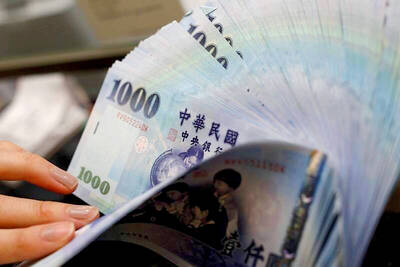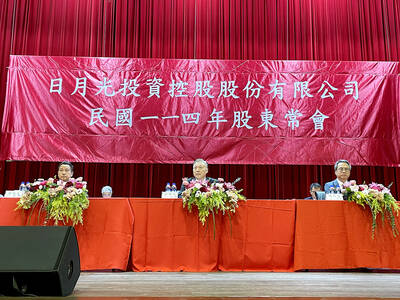The fast growth of online shopping has taken a toll on brick-and-mortar stores, especially in Taipei’s East District (東區), where an increasing number of storefronts sit idle as the number of shoppers shrinks, a survey released on Wednesday by Evertrust Rehouse Co (永慶房屋) showed.
The nation’s retail sales rose 30.9 percent in the past decade to NT$42.77 trillion (US$1.39 trillion) last year, with online transactions rising 69.4 percent and department store sales gaining 46.5 percent, the survey found.
“The figures help explain why many storefronts in the city’s East District have become idle as they increasingly lose attraction and competitiveness as shopping venues,” Evertrust general manager Yeh Ling-chi (葉凌棋) said.
The district refers to the area off Zhongxiao E Road between MRT Zhongxiao Fuxing Station and the Sun Yat-Sen Memorial Hall, which is dotted with restaurants, shops, cafes and boutiques.
A Pacific Sogo Department Store (太平洋崇光百貨) branch and Ming Yao Department Store (明曜百貨), as well as other department stores, are on the main road.
The district’s decline might worsen as consumers become increasingly comfortable with online shopping and do not bother to visit stores that lack economic scale or special characteristics, Yeh said.
Statistics on passenger flows on the city’s MRT metropolitan railway system lent support to the gloomy prediction.
Passenger flows shrank 6.6 percent at MRT Zhongxiao Fuxing Station and 7.4 percent at MRT Zhongxiao Dunhua Station over the past five years, Yeh said.
“That will put correction pressures on storefront rents in the area until they can motivate,” he said.
The western district, better known as Ximen (西門), fared better with a 15.7 percent increase in passenger flows during the same period, thanks to its historical and cultural tourism resources, as well as a plethora of distinctive stores that have proved popular among young foreign travelers, he added.
The Xinyi District (信義) also witnessed an increase of 8.9 percent in passenger volume, with the pace soaring to 26 percent at MRT Taipei 101-World Trade Center Station, Evertrust found.
Consumers of all ages can find attractions at various retail and entertainment facilities in the area that cannot be replaced by online shopping, Yeh said, citing exotic restaurants as an example.
It is time that the government took steps to regenerate the East District, which is losing visitors to Ximen and Xinyi districts, as all three areas are linked by the MRT system, he said.

Merida Industry Co (美利達) has seen signs of recovery in the US and European markets this year, as customers are gradually depleting their inventories, the bicycle maker told shareholders yesterday. Given robust growth in new orders at its Taiwanese factory, coupled with its subsidiaries’ improving performance, Merida said it remains confident about the bicycle market’s prospects and expects steady growth in its core business this year. CAUTION ON CHINA However, the company must handle the Chinese market with great caution, as sales of road bikes there have declined significantly, affecting its revenue and profitability, Merida said in a statement, adding that it would

RISING: Strong exports, and life insurance companies’ efforts to manage currency risks indicates the NT dollar would eventually pass the 29 level, an expert said The New Taiwan dollar yesterday rallied to its strongest in three years amid inflows to the nation’s stock market and broad-based weakness in the US dollar. Exporter sales of the US currency and a repatriation of funds from local asset managers also played a role, said two traders, who asked not to be identified as they were not authorized to speak publicly. State-owned banks were seen buying the greenback yesterday, but only at a moderate scale, the traders said. The local currency gained 0.77 percent, outperforming almost all of its Asian peers, to close at NT$29.165 per US dollar in Taipei trading yesterday. The

RECORD LOW: Global firms’ increased inventories, tariff disputes not yet impacting Taiwan and new graduates not yet entering the market contributed to the decrease Taiwan’s unemployment rate last month dropped to 3.3 percent, the lowest for the month in 25 years, as strong exports and resilient domestic demand boosted hiring across various sectors, the Directorate-General of Budget, Accounting and Statistics (DGBAS) said yesterday. After seasonal adjustments, the jobless rate eased to 3.34 percent, the best performance in 24 years, suggesting a stable labor market, although a mild increase is expected with the graduation season from this month through August, the statistics agency said. “Potential shocks from tariff disputes between the US and China have yet to affect Taiwan’s job market,” Census Department Deputy Director Tan Wen-ling

UNCERTAINTIES: The world’s biggest chip packager and tester is closely monitoring the US’ tariff policy before making any capacity adjustments, a company official said ASE Technology Holding Inc (日月光投控), the world’s biggest chip packager and tester, yesterday said it is cautiously evaluating new advanced packaging capacity expansion in the US in response to customers’ requests amid uncertainties about the US’ tariff policy. Compared with its semiconductor peers, ASE has been relatively prudent about building new capacity in the US. However, the company is adjusting its global manufacturing footprint expansion after US President Donald Trump announced “reciprocal” tariffs in April, and new import duties targeting semiconductors and other items that are vital to national security. ASE subsidiary Siliconware Precision Industries Co (SPIL, 矽品精密) is participating in Nvidia